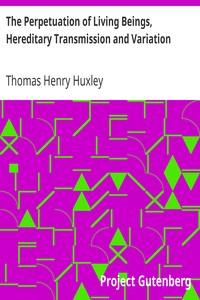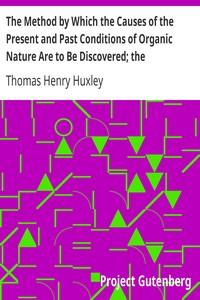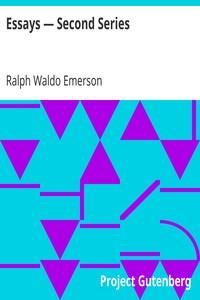Read this ebook for free! No credit card needed, absolutely nothing to pay.
Words: 9532 in 3 pages
This is an ebook sharing website. You can read the uploaded ebooks for free here. No credit cards needed, nothing to pay. If you want to own a digital copy of the ebook, or want to read offline with your favorite ebook-reader, then you can choose to buy and download the ebook.


: The Perpetuation of Living Beings Hereditary Transmission and Variation Lecture IV. (of VI.) Lectures to Working Men at the Museum of Practical Geology 1863 on Darwin's Work: Origin of Species by Huxley Thomas Henry - Evolution (Biology); Darwin Charles 1
THE PERPETUATION OF LIVING BEINGS, HEREDITARY TRANSMISSION AND VARIATION
The inquiry which we undertook, at our last meeting, into the state of our knowledge of the causes of the phenomena of organic nature,--of the past and of the present,--resolved itself into two subsidiary inquiries: the first was, whether we know anything, either historically or experimentally, of the mode of origin of living beings; the second subsidiary inquiry was, whether, granting the origin, we know anything about the perpetuation and modifications of the forms of organic beings. The reply which I had to give to the first question was altogether negative, and the chief result of my last lecture was, that, neither historically nor experimentally, do we at present know anything whatsoever about the origin of living forms. We saw that, historically, we are not likely to know anything about it, although we may perhaps learn something experimentally; but that at present we are an enormous distance from the goal I indicated.
I now, then, take up the next question, What do we know of the reproduction, the perpetuation, and the modifications of the forms of living beings, supposing that we have put the question as to their origination on one side, and have assumed that at present the causes of their origination are beyond us, and that we know nothing about them? Upon this question the state of our knowledge is extremely different; it is exceedingly large, and, if not complete, our experience is certainly most extensive. It would be impossible to lay it all before you, and the most I can do, or need do to-night, is to take up the principal points and put them before you with such prominence as may subserve the purposes of our present argument.
The method of the perpetuation of organic beings is of two kinds,--the asexual and the sexual. In the first the perpetuation takes place from and by a particular act of an individual organism, which sometimes may not be classed as belonging to any sex at all. In the second case, it is in consequence of the mutual action and interaction of certain portions of the organisms of usually two distinct individuals,--the male and the female. The cases of asexual perpetuation are by no means so common as the cases of sexual perpetuation; and they are by no means so common in the animal as in the vegetable world. You are all probably familiar with the fact, as a matter of experience, that you can propagate plants by means of what are called "cuttings;" for example, that by taking a cutting from a geranium plant, and rearing it properly, by supplying it with light and warmth and nourishment from the earth, it grows up and takes the form of its parent, having all the properties and peculiarities of the original plant.
Sometimes this process, which the gardener performs artificially, takes place naturally; that is to say, a little bulb, or portion of the plant, detaches itself, drops off, and becomes capable of growing as a separate thing. That is the case with many bulbous plants, which throw off in this way secondary bulbs, which are lodged in the ground and become developed into plants. This is an asexual process, and from it results the repetition or reproduction of the form of the original being from which the bulb proceeds.
Among animals the same thing takes place. Among the lower forms of animal life, the infusorial animalculae we have already spoken of throw off certain portions, or break themselves up in various directions, sometimes transversely or sometimes longitudinally; or they may give off buds, which detach themselves and develop into their proper forms. There is the common fresh-water Polype, for instance, which multiplies itself in this way. Just in the same way as the gardener is able to multiply and reproduce the peculiarities and characters of particular plants by means of cuttings, so can the physiological experimentalist--as was shown by the Abbe Trembley many years ago--so can he do the same thing with many of the lower forms of animal life. M. de Trembley showed that you could take a polype and cut it into two, or four, or many pieces, mutilating it in all directions, and the pieces would still grow up and reproduce completely the original form of the animal. These are all cases of asexual multiplication, and there are other instances, and still more extraordinary ones, in which this process takes place naturally, in a more hidden, a more recondite kind of way. You are all of you familiar with those little green insects, the 'Aphis' or blight, as it is called. These little animals, during a very considerable part of their existence, multiply themselves by means of a kind of internal budding, the buds being developed into essentially asexual animals, which are neither male nor female; they become converted into young 'Aphides', which repeat the process, and their offspring after them, and so on again; you may go on for nine or ten, or even twenty or more successions; and there is no very good reason to say how soon it might terminate, or how long it might not go on if the proper conditions of warmth and nourishment were kept up.
Sexual reproduction is quite a distinct matter. Here, in all these cases, what is required is the detachment of two portions of the parental organisms, which portions we know as the egg and the spermatozoon. In plants it is the ovule and the pollen-grain, as in the flowering plants, or the ovule and the antherozooid, as in the flowerless. Among all forms of animal life, the spermatozoa proceed from the male sex, and the egg is the product of the female. Now, what is remarkable about this mode of reproduction is this, that the egg by itself, or the spermatozoa by themselves, are unable to assume the parental form; but if they be brought into contact with one another, the effect of the mixture of organic substances proceeding from two sources appears to confer an altogether new vigour to the mixed product. This process is brought about, as we all know, by the sexual intercourse of the two sexes, and is called the act of impregnation. The result of this act on the part of the male and female is, that the formation of a new being is set up in the ovule or egg; this ovule or egg soon begins to be divided and subdivided, and to be fashioned into various complex organisms, and eventually to develop into the form of one of its parents, as I explained in the first lecture. These are the processes by which the perpetuation of organic beings is secured. Why there should be the two modes--why this re-invigoration should be required on the part of the female element we do not know; but it is most assuredly the fact, and it is presumable, that, however long the process of asexual multiplication could be continued, I say there is good reason to believe that it would come to an end if a new commencement were not obtained by a conjunction of the two sexual elements.
That character which is common to these two distinct processes is this, that, whether we consider the reproduction, or perpetuation, or modification of organic beings as they take place asexually, or as they may take place sexually,--in either case, I say, the offspring has a constant tendency to assume, speaking generally, the character of the parent. As I said just now, if you take a slip of a plant, and tend it with care, it will eventually grow up and develop into a plant like that from which it had sprung; and this tendency is so strong that, as gardeners know, this mode of multiplying by means of cuttings is the only secure mode of propagating very many varieties of plants; the peculiarity of the primitive stock seems to be better preserved if you propagate it by means of a slip than if you resort to the sexual mode.
Again, in experiments upon the lower animals, such as the polype, to which I have referred, it is most extraordinary that, although cut up into various pieces, each particular piece will grow up into the form of the primitive stock; the head, if separated, will reproduce the body and the tail; and if you cut off the tail, you will find that that will reproduce the body and all the rest of the members, without in any way deviating from the plan of the organism from which these portions have been detached. And so far does this go, that some experimentalists have carefully examined the lower orders of animals,--among them the Abbe Spallanzani, who made a number of experiments upon snails and salamanders,--and have found that they might mutilate them to an incredible extent; that you might cut off the jaw or the greater part of the head, or the leg or the tail, and repeat the experiment several times, perhaps, cutting off the same member again and again; and yet each of those types would be reproduced according to the primitive type: nature making no mistake, never putting on a fresh kind of leg, or head, or tail, but always tending to repeat and to return to the primitive type.
It is the same in sexual reproduction: it is a matter of perfectly common experience, that the tendency on the part of the offspring always is, speaking broadly, to reproduce the form of the parents. The proverb has it that the thistle does not bring forth grapes; so, among ourselves, there is always a likeness, more or less marked and distinct, between children and their parents. That is a matter of familiar and ordinary observation. We notice the same thing occurring in the cases of the domestic animals--dogs, for instance, and their offspring. In all these cases of propagation and perpetuation, there seems to be a tendency in the offspring to take the characters of the parental organisms. To that tendency a special name is given--it is called 'Atavism', it expresses this tendency to revert to the ancestral type, and comes from the Latin word 'atavus', ancestor.
Well, this 'Atavism' which I shall speak of, is, as I said before, one of the most marked and striking tendencies of organic beings; but, side by side with this hereditary tendency there is an equally distinct and remarkable tendency to variation. The tendency to reproduce the original stock has, as it were, its limits, and side by side with it there is a tendency to vary in certain directions, as if there were two opposing powers working upon the organic being, one tending to take it in a straight line, and the other tending to make it diverge from that straight line, first to one side and then to the other.
So that you see these two tendencies need not precisely contradict one another, as the ultimate result may not always be very remote from what would have been the case if the line had been quite straight.
Free books android app tbrJar TBR JAR Read Free books online gutenberg
More posts by @FreeBooks

: The Method by Which the Causes of the Present and Past Conditions of Organic Nature Are to Be Discovered; the Origination of Living Beings Lecture III. (of VI.) Lectures to Working Men at the Museum of Practical Geology 1863 on Darwin's Work: Origin of Sp


: The Past Condition of Organic Nature Lecture II. (of VI.) Lectures to Working Men at the Museum of Practical Geology 1863 on Darwin's Work: Origin of Species by Huxley Thomas Henry - Evolution (Biology); Darwin Charles 1809-1882. On the origin of species






